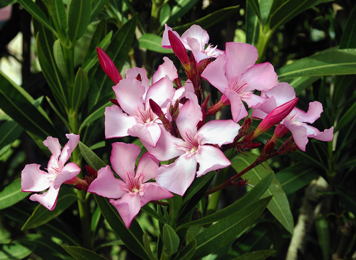Karavira, Indian Oleander (Nerium indicum)

Description of Plant
Karavira is a large glabrous evergreen, shrub with white latex. Karavira consists of various types based on the color of flowers as Red, Yellow, White, etc.
Leaves of this plant are thick and long. In red colored flowers leaves are dark green and in white colored flowers they are light green in color. They are about 17cm in length and 1-3cm in width.
Fruits are cylindrical with Red and White variety are longer about 4 to 6 inch in length with many seeds. The fruit of Yellow variety is round and light red colored (unripe) or grey (ripened fruit) and has 2 seeds of light yellow color. It is poisonous.
The root system of this herbal plant is highly branched. The roots are of grayish color having long irregular streaks.
Stem is grayish or grayish green in color is branched, with similar types of streaks on the bark surface.
Bark is soft and is of Silvery grey white color.
General Description
Karavira is herbal plant which though toxic but has been found to have Ayurvedic uses. Its external application is indicated in bites of poisonous insects. In Ayurveda, this is used in treatment of functional disorders of the heart, in cardiac insufficiency and skin diseases. The stem, leaves and flowers of Karavira contains glycosides.
Leaves have cardio active glycosides which include oleandrin, neriodin, adynerin and other cardiotonic principles like β-D-diginoside as well ursolic acid and a compound similar to rutin.
Roots, bark and seeds consists of neriodorin, nerioderin, karabin, odorin and other cardio active glycosides. The root-bark is reported to contain α-amyrin, β-sitosterol, kaempferol and odoroside B, 4-hydroxy- and 2, 4-dihydroxy acetophenones.
Classification
- Kingdom: Plantae
- Subkingdom: Tracheobionta
- Superdivision: Spermatophyta
- Division: Magnoliophyta
- Class: Magnoliopsida
- Subclass: Asteridae
- Order: Gentianales
- Family: Apocynaceae
- Genus: Nerium
- Species: Indicum
Habitat
This Herbal plant is usually cultivated as ornamental shrub in gardens throughout India. It is found growing in the Himalayas from Nepal westwards to Kashmir up to 1,950m and in upper Gangetic plain and Madhya Pradesh. Also found in Uttar Pradesh, Punjab, Baluchisthan, south India, China and Japan.
It is found on the road sides and grown in the fences in Southern India. Its flowers are used to worship God.
Names
- Hindi Name - Kaner, Kanail
- Telugu Name- Erra Ganneru, Jannerat
- English Name - Indian Oleander
- Punjabi - Kanir
- Bengali Name - Karavi
- Marati Name - Kanher
- Kannada - Kanagilu, Kharjahar, Kanigale, Kanagile
- Assamese - Diflee, Sammulhimar
- Gujarati Name - Kaner, Karena
- Tamil Name - Alari
- Urdu Name - Kaner
- China Name - Kiah chuh-au
- Arabian Name - Sammul hibar
- Farsi name - Kharjahara
Ayurvedic Properties
| Hindi / Sanskrit | English | ||
| Rasa | Katu, Tikta | Taste | Pungent, Bitter |
| Guna | Laghu, Rooksha | Physical Property | Light, Dry |
| Virya | Ushna | Potency | Hot |
| Vipaka | Katu | Metabolic Property (After Digestion) | Pungent |
Effects on Doshas
It balances Kapha and Vata.
Classical Categorization
| Charaka Samhita | Sushrut Samhita | Vagbhata |
|
|
|
Properties and Practical Uses of Nerium indicum
Nerium indicum has so many medicinal properties as bitter, acrid, anthelmintic, adaptogenic, analgesic, aphrodisiac anticancer:, anti-inflammatory: stomachic, febrifuge, diuretic astringent, emetic, expectorant, cardio tonic, anticancer etc.
It is an efficient useful treatment in conditions like snake bites, ulcers, cardiac diseases, asthma, renal and vesicle calculi, chronic stomach diseases, skin related problems, joint pains, leprosy, cancer, etc.
- It can act as abortifacient: causing abortion.
- It is good in relieving pain.
- It is also useful in prevention or treatment of cancer.
- It is benefits in reduction of inflammation.
- It is also act as antibacterial, antiseptic agent.
- It also provides relief as it is good antiulcer.
- It has Bradycardic effect as it can slow the heart rate.
- It has effects as a CNS Depressant which slow brain activity.
- It can induce vomiting required in certain cases.
- It is an Emmenagogue which can stimulate or increases menstrual flow.
- It is good fungicide, insecticide, larvicide, parasiticide, rodenticide.
Part Used
Root/ root bark
Dosage
Powder : 30-125 mg per day, it is the maximum dose.
Cautions
- This herb is a cardiac toxic therefore it should not be used without the advice of doctor.
- It is not safe for children so keep this herb out of sight and reach of children.
- It is also not safe in case of pregnant and lactating mothers and even for external application.
- Accidental oral intake may result in severe poisonous symptoms.

